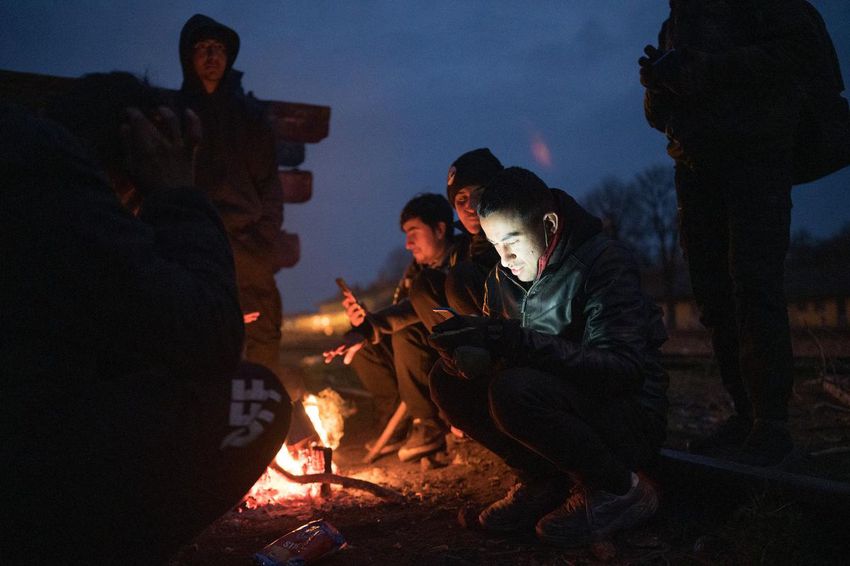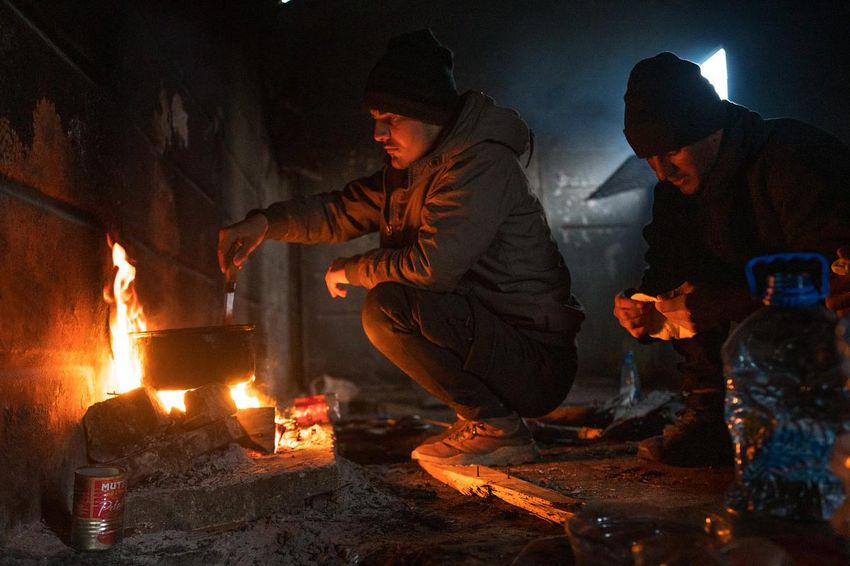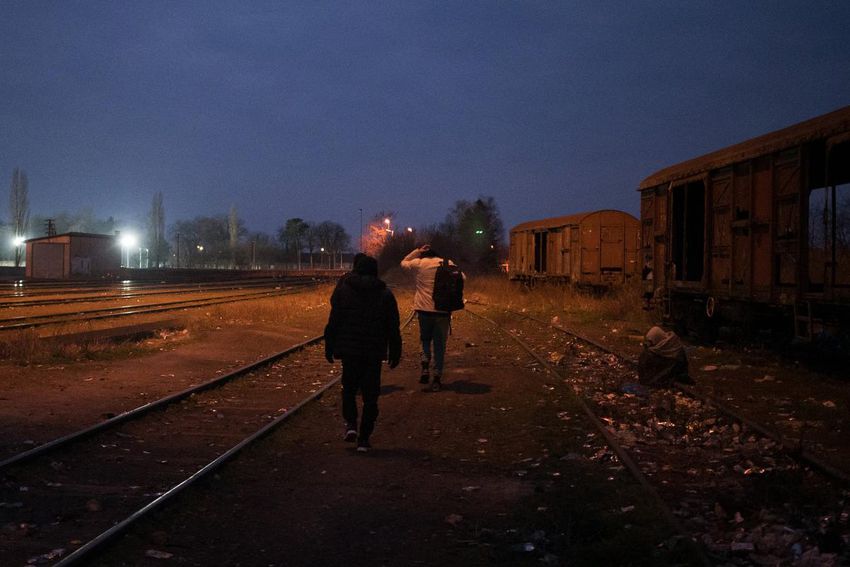SOMBOR, SERBIA—As thousands of Ukrainian refugees crossed into Hungary, Zaid Faisal Hotak, a victim of a different war, was planning his 18th attempt to reach the same country.
The 22-year-old from Laghman province, Afghanistan, is one of a few dozen young Afghans living at a railway station in Sombor, a small town on the northwest edge of Serbia near the borders of European Union countries Hungary and Croatia.
Every few days, they pack small bags and load up on Monster energy drinks so they can stay awake all night as they try once more to cross the EU’s razor-wire border.
They said they know that if they make it across, they’ll likely be stopped and beaten before being sent back to try again.
These young men are just a few of the thousands stranded at Europe’s borders, with no legal pathway to asylum.
Like Ukrainians, many are fleeing war — most are from Afghanistan, but others have traveled from Syria, Iraq and elsewhere, all hoping to reach safety.
A few days earlier at another crossing into Hungary, trainloads of Ukrainians arrived at Zahony station, welcomed by volunteers offering hot food, translation and medical help.
Oksana and her mother, Alina, who would only give their first names, had just finished a hellish three-day drive, fleeing as Russian troops advanced closer to their home in Dnipro, Ukraine. They caught a ride to Vienna with Gerhard Olz, an Austrian who’d already made the 12-hour round trip once with a car full of refugees and was back to pick up more.
“A 10-hour sleep,” Oksana said, when asked what she would do when she got to Vienna.
more than three million Ukrainian refugees have fled into the EU since Russia invaded on Feb. 24.
As crowds of people showed up to support the new Ukrainian arrivals, the scenes at border towns and train stations across Europe were reminiscent of how Syrians and other asylum-seekers were first welcomed on the continent in 2015, when about 1.3 million people arrived.
However, Europe has hardened its borders since then. Now, police patrol with thermal cameras and drones and routinely beat migrants or hold them in secret detention centers before turning them back.
at least 19 people died trying to reach Poland from Belarus last year. Another 19 died on the Turkish border in February after Greek police took their clothes and shoes and pushed them across a river back to Turkey.
These so-called pushbacks are illegal under international law: countries can’t turn someone back at the border without hearing their asylum claim. Still, they’ve become the norm at Europe’s borders. The Danish Refugee Council reported more than 12,000 pushbacks from the EU last year.
Still, rather than seek asylum in Serbia — which rejected 73 per cent of applications in 2020, according to the European Council on Refugees and Exiles — the young Afghans are determined to have their asylum claims heard in the EU, where prospects for work and education are more promising.
On paper, there are two ways to claim asylum in the EU: while inside an EU country, or at the border. Neither way works for most people from Afghanistan, Syria and several other refugee-producing countries: they can’t get visas to travel to the EU, and when Afghans in Sombor managed to cross into Hungary and ask for asylum, police wouldn’t listen , according to Fariydoon Faryad, 15, from Jalalabad: “They say no — go to Serbia.”
That leaves people like Faryad trapped, with no way forward but to keep trying to cross illegally.
Hotak, the 22-year-old from Laghman, has made it across 17 times. He once walked to within 15 kilometers of Austria, he said. But each time, he’s been caught by police and dumped back on the Serbian border.
Many of the boys told similar stories: before driving them back to the border, Hungarian police often beat them or steal their shoes, money and phones.
One of the teens took off his touch to reveal a gash in his scalp — a wound from a Hungarian police baton a few days before, he said.
“The European Union does this on a daily basis,” said Barbara Becares, a spokesperson for No Name Kitchen, an organization that provides food and clean clothing to migrants in Serbia and around the Mediterranean. “Every day you can meet people who have marks of violence on their bodies, people who have no shoes — many times, even people who have no clothes.”
Most of the people the Star spoke with in Serbia had been pushed back at least five times just at this crossing.
“One day, our luck will work,” Hotak said. If he makes it to the EU, it wo n’t be his first time: in 2015 he traveled overland from Kabul, reaching Germany after a year on the road.
He lived there for three years and learned the language before being deported to Bulgaria, where he had been arrested and fingerprinted by border police on his way to Germany.
Normally, EU rules assign refugees to the country where they first landed. Because most people traveling through the Balkans enter illegally, in practice this usually means the country where they first encountered border police.
That rule has been suspended for Ukrainian refugees: under a never-before-used EU directive, they can now live, work and go to school in any member state for a year or longer if the war continues.
“I think this is the model for how we should respond to refugees,” said Serena Parekh, a professor at Northeastern University and author of the book No Refuge: Ethics and the Global Refugee Crisis. “The attitude was one of compassion and solidarity, rather than fear and hostility.”
“The most striking thing is just the night-and-day contrast between how Ukrainians are being welcomed and how people from the Middle East and Africa were welcomed, or rather, not welcomed,” Parekh said.
Hungary, which has so far received at least 300,000 Ukrainians, is one of the EU’s least-friendly countries for migrants. The country’s prime minister called refugees from Syriamuslim invaders” and made it legal to push asylum seekers back across the border.
There are many factors that account for this difference, but race is one of them, Parekh said: “There are all kinds of cultural ties, historical ties (between Ukraine and its neighbours), and this sense that if this war goes badly, it could be in our country.”
“But when you hear the rhetoric about how Ukrainians are good people, they’re like us, they’re safe, you really have a sense of, they’re the deserving refugees and other refugees don’t deserve our help,” Parekh said.
“It’s not to criticize the response to the Ukrainian refugees at all — it’s just to point out that if we can do this, we can also do it for people who are not white,” she said.
In Sombor, the boys cook flatbread on an open fire inside a smoke-filled boxcar whose floor is rotted out. It’s still below zero overnight, and the boxcar, where they also sleep, offers little shelter.
The youngest, Jawed Khogyani, is 14. Most aren’t older than 16. After traveling more than 5,000 km, mostly on foot, their world has shrunk to not much more than this railway station and the back seat of a taxi on the way to the border.
Hotak was 15 when he left Kabul seven years ago. Now 22, he’s spent much of his young adult life on the road. Going back to Afghanistan is unthinkable, he said.
He’s determined to make it back to the EU — aiming for Italy this time: “If you have a big heart, and you don’t care about anything, it’s possible. I’m not scared.”
JOIN THE CONVERSATION


